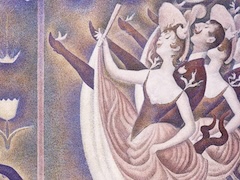A Sunday Afternoon on the Island of La Grande Jatte by Georges Seurat

To comment on this vast canvas where Seurat for the first time succeeded in applying, with scientific rigor, the theory of optical mixture by the division of tone - a technique that Peter Paul Rubens and Eugène Delacroix had employed intuitively - one cannot do better than to quote the following text by Jules Christophe. It was published in Les Hommes d' aujourd'hui, an issue devoted to Georges Seurat. The list of motives was dictated and revised by the artist himself:
Under a blazing mid-afternoon summer sky, we see the Seine flooded with sunshine, smart townhouses on the opposite bank, and small steamboats, sailboats, and a skiff moving up and down the river. Under the trees closer to us many people are strolling, others are sitting or stretched out lazily on the bluish grass. A few are fishing. There are young ladies, a nursemaid, a Dantesque old grandmother under a parasol, a sprawled-out boatman smoking his pie, the lower part of his trousers completely devoured by the implacable sunlight. A dark-colored dog of no particular breed is sniffing around, a rust-colored butterfly hovers in mid-air, a young mother is strolling with her little girl dressed in white with a salmon-colored sash, and two budding Army officers from Saint-Cyr are walking by the water. Of the young ladies, one of them is making a bouquet, another is a girl with red hair in a blue dress. We see a married couple carrying a baby, and, at the extreme right, appears a scandalously hieratic-looking couple, a young dandy with a rather excessively elegant lady on his arm who has a yellow, purple, and ultramarine monkey on the leash.
There was public resistance to the picture at first, Arsene Alexandre tells us:
Everything was so new in this immense painting - the conception was bold and the technique one that nobody had ever seen or heard of before. This was the famous Pointillism".
When exhibited at the Indépendents, the work aroused sneers and indignation. "There were outcries," Christophe goes on to say, "but by standing its ground the picture's revolutionary character won out in the end. Its success was immediately hailed in La Vogue, to which Felix Feneon contributed a lively, logical and well-informed article."

Before its acquisition by the Art Institute of Chicago, the painting was owned successively by Georges Seurat's mother, Maximilien Luce.
















